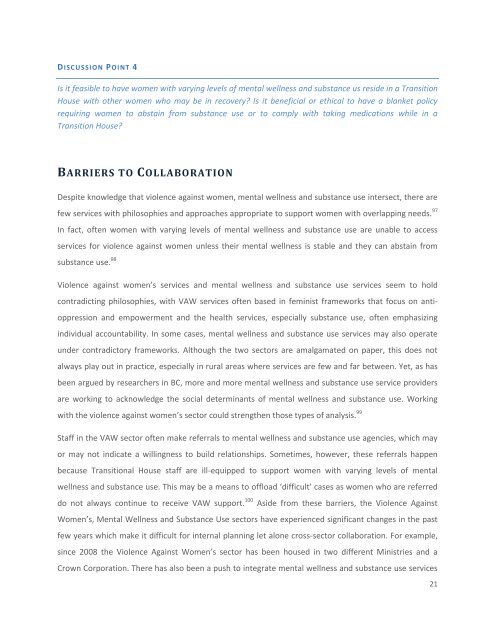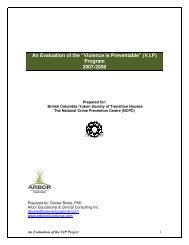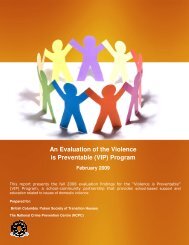reducing barriers to support - BC Society of Transition Houses
reducing barriers to support - BC Society of Transition Houses
reducing barriers to support - BC Society of Transition Houses
Create successful ePaper yourself
Turn your PDF publications into a flip-book with our unique Google optimized e-Paper software.
DISC USSI ON POINT 4<br />
Is it feasible <strong>to</strong> have women with varying levels <strong>of</strong> mental wellness and substance us reside in a <strong>Transition</strong><br />
House with other women who may be in recovery Is it beneficial or ethical <strong>to</strong> have a blanket policy<br />
requiring women <strong>to</strong> abstain from substance use or <strong>to</strong> comply with taking medications while in a<br />
<strong>Transition</strong> House<br />
BARRIERS TO COLLABORATION<br />
Despite knowledge that violence against women, mental wellness and substance use intersect, there are<br />
few services with philosophies and approaches appropriate <strong>to</strong> <strong>support</strong> women with overlapping needs. 97<br />
In fact, <strong>of</strong>ten women with varying levels <strong>of</strong> mental wellness and substance use are unable <strong>to</strong> access<br />
services for violence against women unless their mental wellness is stable and they can abstain from<br />
substance use. 98<br />
Violence against women’s services and mental wellness and substance use services seem <strong>to</strong> hold<br />
contradicting philosophies, with VAW services <strong>of</strong>ten based in feminist frameworks that focus on antioppression<br />
and empowerment and the health services, especially substance use, <strong>of</strong>ten emphasizing<br />
individual accountability. In some cases, mental wellness and substance use services may also operate<br />
under contradic<strong>to</strong>ry frameworks. Although the two sec<strong>to</strong>rs are amalgamated on paper, this does not<br />
always play out in practice, especially in rural areas where services are few and far between. Yet, as has<br />
been argued by researchers in <strong>BC</strong>, more and more mental wellness and substance use service providers<br />
are working <strong>to</strong> acknowledge the social determinants <strong>of</strong> mental wellness and substance use. Working<br />
with the violence against women’s sec<strong>to</strong>r could strengthen those types <strong>of</strong> analysis. 99<br />
Staff in the VAW sec<strong>to</strong>r <strong>of</strong>ten make referrals <strong>to</strong> mental wellness and substance use agencies, which may<br />
or may not indicate a willingness <strong>to</strong> build relationships. Sometimes, however, these referrals happen<br />
because <strong>Transition</strong>al House staff are ill-equipped <strong>to</strong> <strong>support</strong> women with varying levels <strong>of</strong> mental<br />
wellness and substance use. This may be a means <strong>to</strong> <strong>of</strong>fload ‘difficult’ cases as women who are referred<br />
do not always continue <strong>to</strong> receive VAW <strong>support</strong>. 100 Aside from these <strong>barriers</strong>, the Violence Against<br />
Women’s, Mental Wellness and Substance Use sec<strong>to</strong>rs have experienced significant changes in the past<br />
few years which make it difficult for internal planning let alone cross-sec<strong>to</strong>r collaboration. For example,<br />
since 2008 the Violence Against Women’s sec<strong>to</strong>r has been housed in two different Ministries and a<br />
Crown Corporation. There has also been a push <strong>to</strong> integrate mental wellness and substance use services<br />
21






